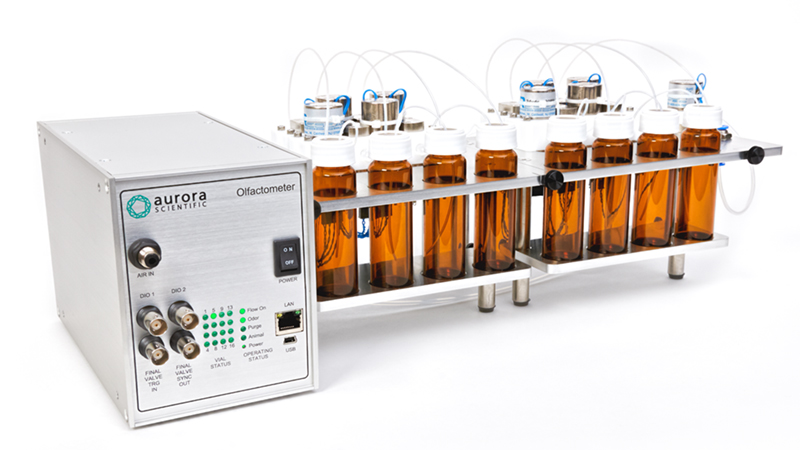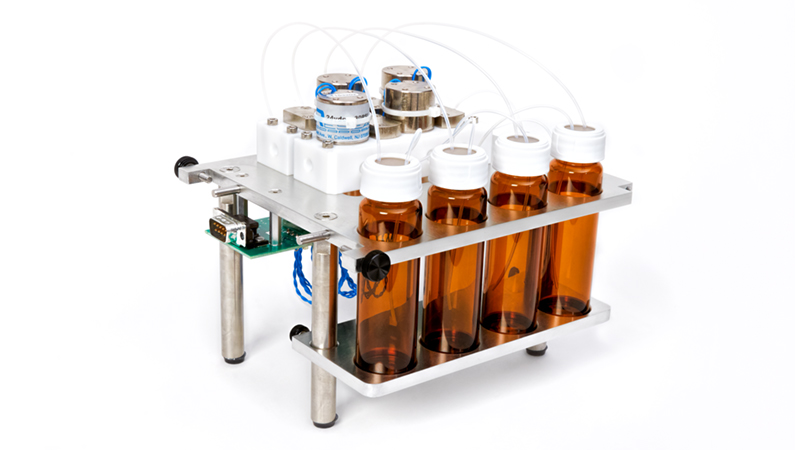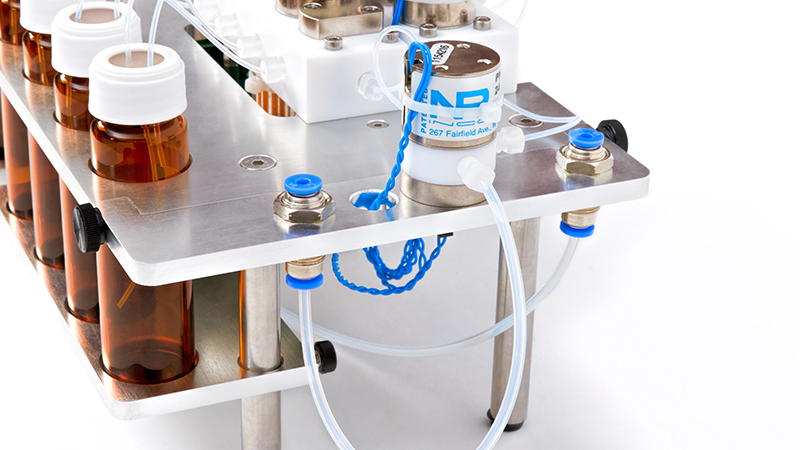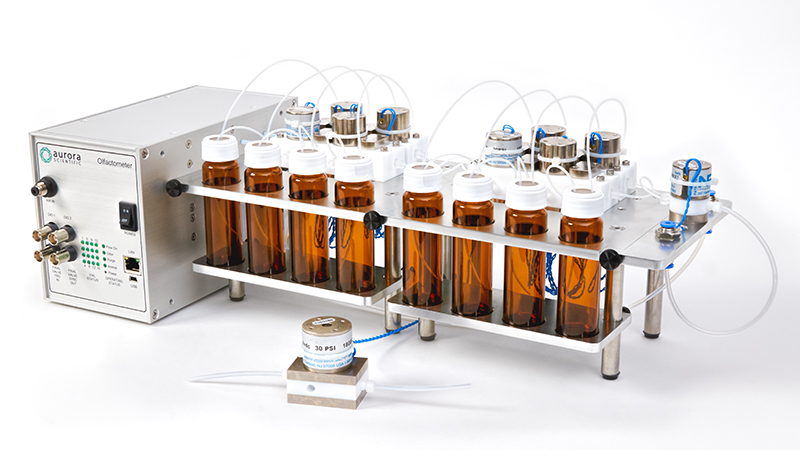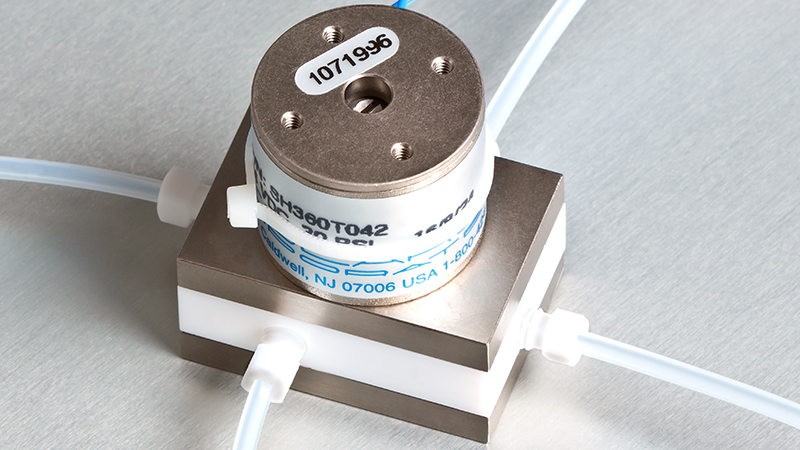220A: Olfactometer
The 220A Olfactometer provides reliable odor generation for demanding olfaction experiments. The 220A can be configured with 4, 8, 12 or 16 odor vials for maximum flexibility. Careful fluid design ensures repeatable odor profiles generated with minimum delay time between activation and arrival of the odor at the subject.
The 220A delivers odors of the desired concentration at the precise time required for studying behavioural response, central processing of olfactory information in the brain and for sensory physiology.
The design was originally developed by Prof. Rinberg and is licensed from HHMI Janelia Farm. The 220A Olfactometer performs multiple odor applications during an experiment without changing the odor vials.
Variant
220A-V Olfactometer Expansion Module:
4 channel expansion module, expanding your olfactometer to up to 16 odor vials
Stories of Success
200B – Characterizing Olfactometers
CHALLENGE
In 2011 Prof. Burton Slotnick approached us with a need to characterize an olfactometer of his design. Prof. Slotnick was a pioneer in olfactometer design for studying behavioral and neurobiological aspects of odor learning in rats and mice. The olfactometer described in his 1999 paper co-authored with Natalya Bodyak was the basis for the Knosys olfactometer which he now wanted to characterize. For this work he required a gas sensor that could respond fast enough to measure the arrival time and concentration profile of his olfactometer. He also required software that could record the gas sensor signal and correlate these signals with the timing pulses generated by the olfactometer.
SOLUTION
Aurora Scientific knew that the 200B miniPID could perform the characterization required but at the time software was not available. To solve this our R&D team wrote a LabVIEW program that collected and analysed data from a miniPID sensor. The software (210A: GasTrack) performed sensor calibration, data collection, background signal subtraction, conversion of sensor output to concentration, recording of timing signals and plotting of results.
RESULTS
A miniPID sensor and data acquisition system were provided to Prof. Slotnick and he was able to use it to measure the arrival time and concentration profile of the odor pulses produced by his olfactometer. The GasTrack software became commercially available to accompany the 200B miniPID gas sensor as a complete, easy-to-use data acquisition system.
Select References
- Rinberg, Dmitry, Alex Koulakov, and Alan Gelperin. “Speed-Accuracy Tradeoff in Olfaction” Neuron (2006) DOI: 10.1016/j.neuron.2006.07.013
- Rinberg, Dmitry, Alex Koulakov, and Alan Gelperin. “Sparse odor coding in awake behaving mice.” The Journal of Neuroscience (2006) DOI: 10.1523/JNEUROSCI.0884-06.2006
- Koulakov, Alexei A., and Dmitry Rinberg. “Sparse incomplete representations: a potential role of olfactory granule cells.” Neuron (2011) DOI: 10.1016/j.neuron.2011.07.031
- Parnas et al. “Precision detection of select human lung cancer biomarkers and cell lines using honeybee olfactory neural circuitry as a novel gas sensor” Biosensors and Bioelectronics (2024) DOI: 10.1016/j.bios.2024.116466
- Shusterman, Roman et al. “Precise olfactory responses tile the sniff cycle.” Nature Neuroscience (2011) DOI: 10.1038/nn.2877
- Conway et al. “Perceptual constancy for an odor is acquired through changes in primary sensory neurons” Science Advances (2024) DOI: 10.1126/sciadv.ado9205
- Smear, Matthew et al. “Perception of sniff phase in mouse olfaction.” Nature (2011) DOI: 10.1038/nature10521
- Koulakov, Alexei, Alan Gelperin, and Dmitry Rinberg. “Olfactory coding with all-or-nothing glomeruli.” Journal of Neurophysiology (2007) DOI: 10.1152/jn.00560.2007
- Dewan, Adam et al. “Non-redundant coding of aversive odours in the main olfactory pathway.” Nature (2013) DOI: 10.1038/nature12114
- Farnum et al. “Harnessing insect olfactory neural circuits for detecting and discriminating human cancers” Biosensors and Bioelectronics (2023) DOI: 10.1016/j.bios.2022.114814
Related Products
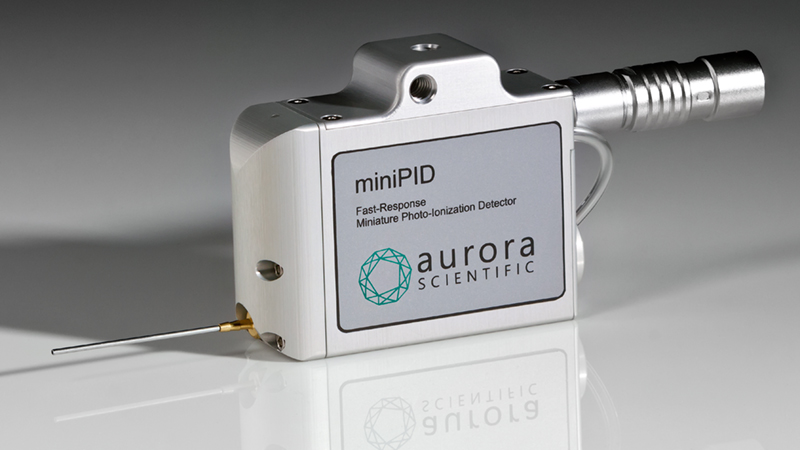
200C: miniPID Fast Response Olfaction Sensor
The 200C miniPID photo-ionization detector combines small size, fast response, and high sensitivity in an easy-to-use, competitively priced package.
Learn MoreExplore Further
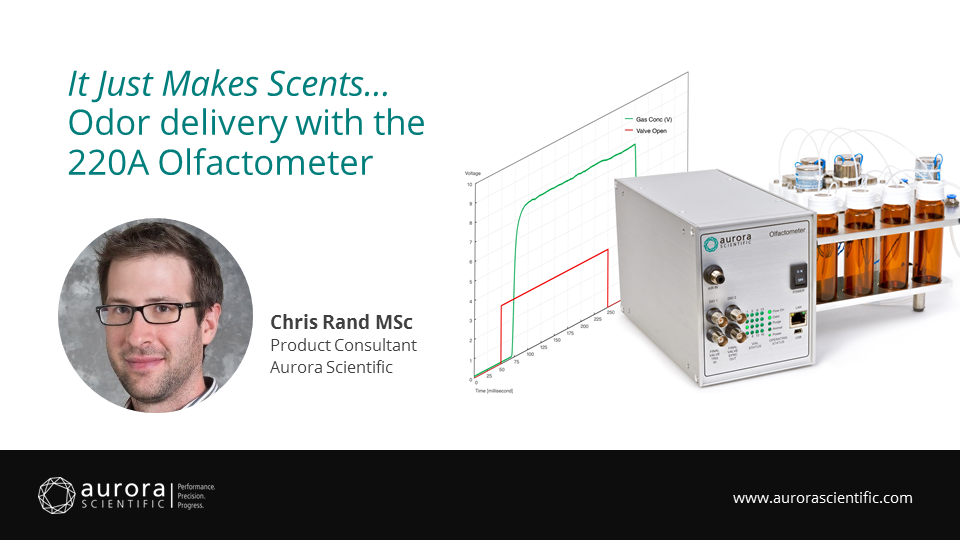
It Just Makes Scents…Odor delivery with the 220A Olfactometer
The 220A Olfactometer by Aurora Scientific has been updated and during this tech cast, Chris takes viewers through live demonstrations while sharing tips, tricks and best practices for optimal ...
Learn MoreResources
Specifications
| 220A-4,-8,-12,-16 | 220A-V | |
|---|---|---|
| Modules Included | All Models: MFC, Mixing, Final 220A-4: 1x 4-Vial Odor 220A-8: 2x 4-Vial Odor 220A-12: 3x 4-Vial Odor 220A-16: 4x 4-Vial Odor |
4-Vial Odor add-on |
| Mass Flow Controllers [SCCM1] | Odor: 0-100 Dilution: 0-1000 Exhaust: 0-1000 |
NA |
| Total Flowrate Range [SCCM2] | 100-1000 | NA |
| Odor Vials | 220A-4: 4 220A-8: 8 220A-12: 12 220A-16: 16 |
4 |
| Odor Dilution Range [%] | 0.1-10 | NA |
| Odor Pulse Delay [ms] | 40 | NA |
| Odor Pulse Duration [ms] | 30 – continuous | NA |
| Communications | Ethernet | NA |
| Final Valve Sync Output | BNC, TTL signal Hi: Final Valve Flows to Animal Lo: Final Valve Flows to Exhaust |
NA |
| Final Valve Trigger In | BNC, TTL signal triggers opening of Final Valve Hi: Final Valve Flows to Animal Lo: Final Valve Flows to Exhaust |
NA |
| DIO 1 Input | BNC, TTL Sequence Trigger | NA |
| DIO 2 Output | BNC, Configurable by user: Sequence Sync Out or Vial Status | NA |
1 = Standard Cubic Centimeters per Minute; 2 = Standard Cubic Centimeters per Minute
| General Specifications | 220A-4,-8,-12,-16 | 220A-V |
|---|---|---|
| Operating Temperature [°C] | 0 – 40 | 0 – 40 |
| Power Required | In: 100-240 VAC, 50/60 Hz. @ 1.8A | 48VDC supplied by 220A |
| Power Consumption [W] | 15 | 10 |
| Weight [kg] | 220A-4: 4.6 220A-8: 6.2 220A-12: 7.8 220A-16: 9.4 |
1.6 |
| Dimensions [cm] | MFC: 12L x 20W x 14H 4-Vial Odor: 18L x 15W x 15H Mixing Valve: 4L x 15W x 5H Complete Instrument: 220A-4: 31L x 20W x 15H 220A-8: 48L x 20W x 15H 220A-12: 65L x 20W x 15H 220A-16: 82L x 20W x 15H |
18L x 15W x 15H |
| Software Specifications | 220A-4,-8,-12,-16 and 220A-V |
|---|---|
| Main Window | Readouts: Flowrate, Vial Flow %, Odor Delivery Duration Status LEDs: Flow, Odor, Purge and Animal, Vial Selection Controls: Flow Odor To Exhaust, Purge, Deliver Odor to Animal, Stop Flow Status line |
| System Configuration Window | Vial list showing Odorant, Solvent and Concentration Controls: Odor Flow Stabilization Delay, Total System Flow Rate Load and Save Config file |
| Advanced Status and Control Window | Displays graphical representation of the olfactometer’s current state and allows manual control of flowrates and valves |
| Valve Check | System check which cycles each valve sequentially |
| Sequencer Window | Create challenge sequences, controls vial, delay time, delivery time Allows sequence to be randomized. Load and Save sequence files |

